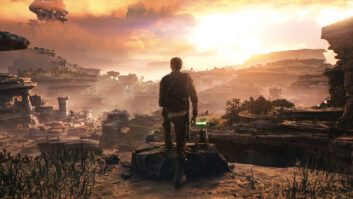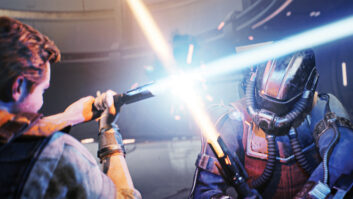Since its release, Bradley Cooper’s Golden Globe- and Grammy-nominated film A Star Is Born has been moving audiences with his and Lady Gaga’s musical performances. The two sing original rockers and ballads, backed mostly by Lukas Nelson and his band, Promise of the Real, all performed. . . live. . . .right? Well, yes, and no.
The film, similar to its previous renditions, tells the story of a huge, but beginning to fall, country rocker, Jackson Maine (Cooper), who discovers a new talent, Ally (Gaga), whose career he helps launch as his alcohol-fueled failure deepens. Interspersed in the dramatic story are skillfully shot and recorded concert sequences, filmed at venues such as The Greek Theater, Coachella Festival, Stagecoach Festival, The Shrine Auditorium, The Forum and even England’s Glastonbury Festival.
Films that include musical performances are not easy to shoot or mix, and nothing takes the audience out of the experience more than an abrupt shift to an obviously pre-recorded song, the actors clearly miming along. From the earliest production meetings, it was clear that Gaga in particular would have none of that.
“We had a lot of meetings in pre-production,” notes music editor Jason Ruder, “trying to figure out what road we were going to take with the music. But even in early talks, Gaga knew she wanted all of the vocals to be live—she was adamant about it. And Bradley loved the idea.”
The challenge, then, was how to pull it off with a level of authenticity that never reveals itself to the audience. An expert team, including Ruder, production sound mixer Steven Morrow and Pro Tools editor Nick Baxter—all veterans of another hit musical, La La Land—came together to develop a system, drawing on their experience from that film. “The advantage here,” says Morrow, “is that they’re portraying rock stars—they will be seen on camera singing into [SM57[ microphones.” On La-La Land, it was all hidden wireless.
While Gaga initially hoped to have vocals and band both perform live,, there are risks to that approach when doing so for camera. “Warner Bros. and myself were a little nervous about that idea,” Morrow recalls. “No matter how great a musician is, they’re going to play at different tempos every day and take to take. It just won’t cut together well.”
Vocals, they knew, would need to be recorded cleanly to allow them to be able to placed effectively into the final mix. Morrow suggested, then, pre-recording Cooper, Nelson and band and playing back the pre-records of the instrumentation in earwigs, allowing the band to mime to their own recording, while killing the guitar amps out loud, deadening the drums as much as possible, and recording Cooper and/or Gaga singing live, as they listen to the playback in their ComTech in-ear monitors.
Key to the success of this setup was the use of impulse response measurement of each venue in which the cast was filmed and recorded. “Gaga was especially concerned about reverbs and ambience and environments,” Ruder says. So he enlisted Baxter, who had specific expertise in IR work, to set up the system.
Baxter utilized Audio Ease Altiverb 7 convolution reverb plug-in to both do the measurement and create an appropriate reverb for each venue.
“It’s an impulse response reverb engine,” he explains. “It comes with a tone sweep, a sine wave which sweeps up from 20 Hz to 20k Hz, through the whole frequency spectrum. And you blast that out through speakers in whatever environment you’re in and record it back.”
The sweep was recorded using a favorite instrument of Morrow’s, his DPA 5100 surround microphone set at center stage, aiming out into the venue. “You’re with the band for so many of those shots, so we wanted to make sure we had an image of what the venue sounded like to them, onstage, instead of out in the audience,” Morrow says. “So we had mics up onstage to capture the impulse response as it sounds up there, as well. And you can switch between the two, as the picture edit requires.”
Though Ruder broached the subject with the assistant directors in prep, it took some doing to convince them and the studio that the 5 or 10 minutes of quiet time at locations was imperative to create the effect Gaga and Cooper wanted. “It became kind of a joke,” laughs Baxter. “It’s really loud. We’d clear the set and make this loud noise for 10 minutes.”
Before fully committing to the process, a test was set up on a stage at Warner Bros, in which a song was shot and recorded twice: once with the band and singers all miked and performing live (and using Baxter’s IR system to capture the profile of the soundstage), and then one in which the band quietly mimed to playback of a pre-record while Cooper/Gaga sang live to tape. Ruder than took the two recordings to his 5.1 mix room on the lot and created mixes of the two performances, which were then played back to Cooper and team. Says Ruder, “Everybody went, ‘Okay, this is really cool. We gotta make sure we catch everything we need on set, but it’s going to work.”
Tracking the Prerecords
The songs Gaga, Cooper and the band are seen performing in the film were written by various combinations of writers, including them and Nelson, Jason Isbell, Mark Ronson, Nick Monson and Paul “DJ WS” Blair. The recordings were made at a few studios (including some early tracking produced by Dave Cobb in Nashville), with a good deal done at The Village West’s Studio D, Eastwest Studios, Woodrow Wilson Studios (Gaga’s recording facility) and elsewhere.
While Gaga, Cooper and Nelson produced many of the recordings, nearly all were engineered (and several co-produced, including the Grammy-nominated “Shallow”) by Benjamin Rice. Rice had been a staff engineer at Record Plant in 2013, during the recording of Gaga’s ARTPOP, and was tapped by Rose Mann-Cherney one day, to fill in as engineer. “At the end of the day,” he remembers, “Gaga walked out of the studio and gave me a high five and said, ‘Well, I’ll see you in the morning—just me and you.’” The two have worked together ever since.
[Rice even appears in the film, in scenes actually shot at Village Studio D, showing Ally and Jack doing their first recordings.]
The approach to the recordings was to be live, as a band, creating what the musicians would sound like if they were performing live in concert. “I was trying to make the band sound ‘live’ in the studio, keeping in mind that this needed to be very raw and natural, just gritty and cool sounding. And that’s just naturally their wheelhouse—they’re used to being able to perform a record and not having to worry about dissecting it with overdubs. He and those guys are just so incredibly talented as musicians.”
Key for each track, he notes, was being certain all understood how that song fit into the story and character arcs. “That was always at the forefront of our minds,” he explains, “’What is the sound supposed to be?’ And we would try approaches with different instrumentation that may work, it may not. And just circle into ‘This is the sound for Jackson,’ or ‘This is the sound for Ally.’”
Cooper and Nelson’s “Out of Time,” for instance, is heard as Ally finally gives in to Jack’s wishes to have her join him for the first time at one of his concerts, eventually coming onstage.
“Bradley wanted it wooing her to the stage, pulling her closer and closer to him,” Rice explains. “He said, ‘I want a long song, but have it just start to explode, more and more, culminating in her finally getting close to him onstage. He’s trying to get her to come see him again. So I want the drums building and the bass to build, and I want a solo that builds.’ He was very specific. I’ve never worked with a director who was so hands-on. He really did his homework and knew precisely what his vision was. And there was nothing better than to hear him say, ‘Ben, this is the Jackson sound. This is what I’m talking about.’”
Read the full story in the January issue of Mix.







